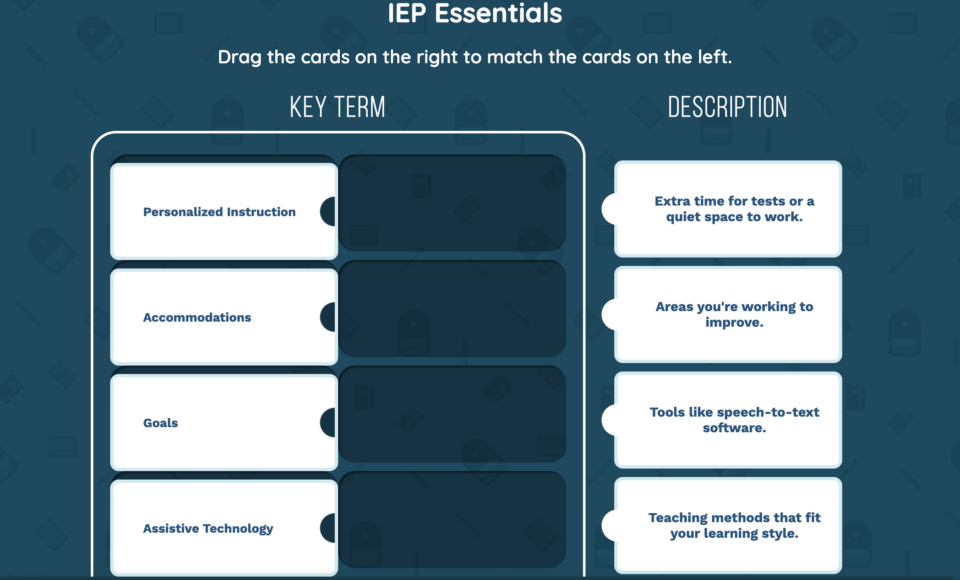
As a middle school special educator, guiding your students through the complexities of an Individualized Education Program (IEP) can be both challenging and rewarding. IEPs are crucial in ensuring that students with disabilities receive the personalized support they need to succeed academically and socially. However, helping students understand the components of their own IEPs can be difficult. Accordingly, this is where Everyday Speech’s Interactive IEP Activity for Middle School Students comes into play.
To make this process more engaging and accessible, Everyday Speech has thoughtfully developed a digital interactive matching activity specifically designed to teach middle school students about the essential components of an IEP. Additionally, this activity provides a hands-on learning experience where students can match key IEP terms with their corresponding descriptions. Consequently, this approach makes it significantly easier for students to grasp these critical concepts. Furthermore, this tool not only aids in comprehension but also empowers students to take an active role in their education.
The Importance of Teaching IEP Components
An IEP is more than just a legal document; it’s a personalized roadmap for a student’s educational journey. It outlines the specialized instruction, accommodations, and services that will support the student’s unique learning needs. By understanding their IEP, students can become more active participants in their education, advocating for themselves and making informed decisions about their learning.
For students with disabilities, self-advocacy is a vital skill. It empowers them to communicate their needs, preferences, and goals to their teachers, parents, and peers. When students understand the components of their IEP, they are better equipped to take ownership of their education and work collaboratively with their support team.
Introducing the Interactive IEP Activity for Middle School Students
Everyday Speech’s Interactive IEP Matching Activity is a powerful tool designed to simplify the process of teaching IEP components to middle school students. This digital activity allows students to engage with the material in a way that is both interactive and educational. Here’s how it works:
1. Key Terms and Descriptions
The activity presents students with a list of key IEP terms, such as “Personalized Instruction,” “Accommodations,” “Goals,” and “Assistive Technology.” On the opposite side of the screen, students will find descriptions for each term. For example, “Accommodations” might be described as “Extra time for tests or a quiet space to work.”
2. Drag-and-Drop Interaction
Students are then prompted to match each key term with its correct description by dragging and dropping the cards. This interactive approach makes learning more engaging and helps reinforce the connection between the term and its meaning.
3. Feedback
Once a student completes the activity, they receive immediate feedback on their answers. This instant feedback is crucial for correcting misunderstandings and solidifying their knowledge.
4. Discussion and Reflection
After completing the activity, it’s essential to have a discussion with your students about what they’ve learned. This can include reviewing the correct matches, exploring why each component is important, and discussing how these components apply to their own IEPs.

How This Activity Supports Learning
The Interactive IEP Matching Activity is designed to accommodate a variety of learning styles and needs. Here are some of the ways it can benefit your students:
- Engagement: The digital, interactive format captures students’ attention and makes learning about IEPs more enjoyable.
- Accessibility: The activity can be adapted to suit the needs of students with different abilities, ensuring that all students can participate and benefit.
- Reinforcement: By matching terms with descriptions, students reinforce their understanding of each IEP component, making it more likely that they will remember these concepts.
- Self-Advocacy: As students become more familiar with the components of their IEPs, they are better prepared to advocate for themselves in educational settings.
Accessing the Activity and Additional Resources
The Interactive IEP Matching Activity is part of Everyday Speech’s comprehensive suite of digital tools designed to support social-emotional learning. Educators can access this activity and many other resources by signing up for a free trial on the platform.
In addition to the matching activity, we offer a variety of video modeling lessons and interactive activities. Our resources are designed to make complex topics more accessible for students with diverse learning needs.
Unlock all of our Self-Advocacy materials by signing up for your free trial today – no credit card required!
Access the full Social Communication Curriculum HERE!
Instant access to thousands of no-prep social skills activities, over 1000+ video lessons, and engaging games designed to enhance learning and development.
Conclusion
As a special educator, your goal is to empower your students to take an active role in their education. By helping them understand their IEP, you are giving them the tools they need to succeed both academically and socially. The Interactive IEP Matching Activity from Everyday Speech is an excellent resource to support this mission.
You can ensure that your students not only understand their IEPs but also feel confident in advocating for their needs. As they progress through middle school, this understanding will serve as a foundation for their continued growth and success.
Sample Video
Students learn best by watching others their same-age model the behavior! Check out a sample video modeling lesson below. We offer our entire Social-Emotional Learning platform free for 14 days here!
Related Blog Posts:
Navigating Middle School: Enhancing Social Skills Through Videos
Teaching Middle School Students to Stay Calm and Solve Problems
Promoting Mental Well-being: SEL Lessons for Middle School Students





